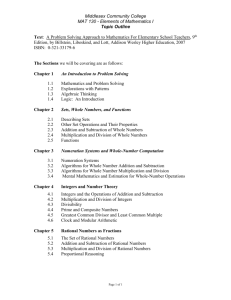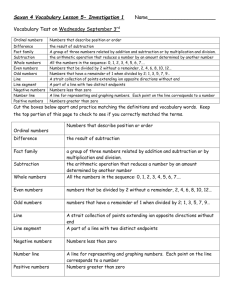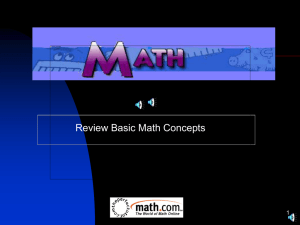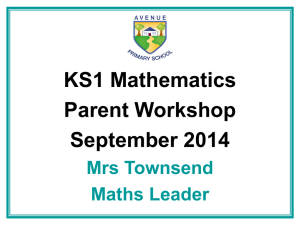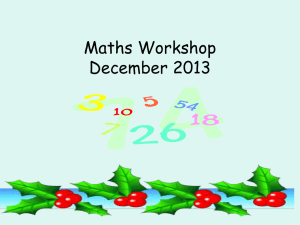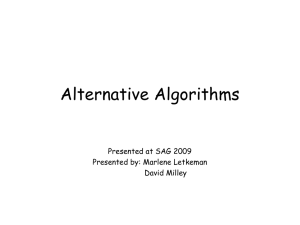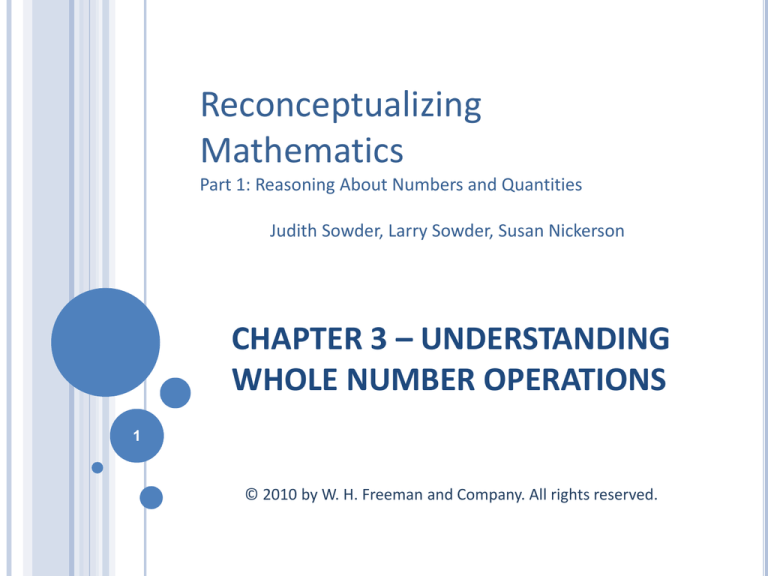
Reconceptualizing
Mathematics
Part 1: Reasoning About Numbers and Quantities
Judith Sowder, Larry Sowder, Susan Nickerson
CHAPTER 3 – UNDERSTANDING
WHOLE NUMBER OPERATIONS
1
© 2010 by W. H. Freeman and Company. All rights reserved.
3-2
ACTIVITY
3-3
3-4
EXAMPLE
3-5
EXAMPLE
What would the diagram look like?
3-6
ACTIVITY
3-7
3.1
3-8
A problem situation that calls for addition often
describes one quantity being physically, or
actively, put together with another quantity.
The term joining is also often used.
Example:
3-9
Another type of problem that involves addition
involves conceptually (versus physically or
literally) placing objects together.
Example:
3-10
3-11
Example:
3-12
3-13
Example:
3-14
Example:
3-15
3-16
Example:
3-17
ACTIVITY
Pair up with someone in the class and…
a) classify each of the problem situations below (e.g.,
comparison subtraction):
b) write problem situations that illustrate four of the
different views presented for addition or
subtraction.
3-18
3.2
Addition is a combining that is done actively or conceptually.
Subtraction is classified in one of three ways:
take-away, comparison, and missing addend.
It is important that a teacher illustrate all the ways that addition
and subtraction come into play when giving examples of their use in
story problems. Elementary school teachers often only illustrate
the “take away” case when introducing subtraction examples.
Students should be asked to use addition and subtraction in both
the discrete and continuous case of quantities.
3-19
Children who understand place value and
have not yet learned a standard way to
subtract often have very unique ways of
undertaking subtraction.
Prepare to be surprised!!
3-20
ACTIVITY
Consider the work of nine second-graders as
displayed on the following slide, all of whom
were asked to solve 364 – 79 in written form
without calculators or base-ten blocks.
a) Which students clearly understand what
they are doing, which ones might
understand, and which do not understand?
b) Describe in writing the steps the students
followed to complete their work.
3-21
3-22
Is any one of these methods of subtraction better than
the others? Why or why not? Which methods could be
more easily understood? Are there any that should not
be taught? Why or why not?
3-23
3.3
Children do not think about math the same way adults
do. Adults have a wider range of experience with
numbers. But consider that part of the reason is that we
had limited opportunities to explore numbers and the
meanings of operations. We became “set in our ways”
so to speak. Young children are often inquisitive and
this can be used to their advantage. Coming up with
novel ways to solve problems often brings with it a
deeper, more conceptually based understanding. The
use of traditional algorithms can still be taught to
children, but only after children have the opportunity to
explore meanings for themselves.
3-24
3-25
DISCUSSION
Researchers have found that success on the second
problem is up to 40% less than the first, even among
adults. Many solvers think they should divide or subtract
on the second problem. Why would that happen?
3-26
Example:
3-27
3-28
3-29
Example:
Let’s say that Jim needs to bake 2/3 of seven pounds
of meat. We represent this as 2/3 7. Note that the
multiplication sign represents the word “of” here in
this fractional part example. Here the unit or whole
is the seven pounds of meat.
3-30
3-31
3-32
Activity
Suppose Jane has three different colors of turtle-necks,
four different sweaters, and three different pairs of
slacks. Assuming they are all color compatible, and that
she will always wear one of each, how many different
ways can she dress?
How could this be represented with a diagram?
3-33
Activity
3-34
PROPERTIES OF MULTIPLICATION
Commutative Property of Multiplication:
mn = nm (for numbers m and n)
Associative Property of Multiplication:
(pq)r = p(qr) (for numbers p, q, r)
Distributive Property of Multiplication:
c (d + e) = cd + ce (for numbers c, d, e)
3-35
3.4
continued….
3-36
3-37
Example:
3-38
Example:
3-39
3-40
3-41
ACTIVITY
Hint: In which case will repeatedly subtracting the 2.5 yield the
correct response? In which case must the miles instead be
rationed out to totally separate “objects”? Carefully discuss this
activity until the difference is clear.
3-42
DISCUSSION
Write two word problems for each of the two
divisions shown below. One problem should
reflect the use of repeated subtraction, and the
other should reflect sharing equally.
a) 85 ÷ 7
b) 4.8 ÷ 2
3-43
Example:
3-44
DISCUSSION
3-45
3.5
3-46
3-47
DISCUSSION
Discuss what you think each child was thinking
about in terms of their approach to the
problem based on their work given on the
following slide.
3-48
3-49
DISCUSSION
Below is the work of two seven-year-olds. Neither of
these children knew the standard division algorithm, but
still got by quite well without it. You are to study each
method and tell what each child was thinking :
3-50
DISCUSSION
Examine and discuss each of these student’s thinking
process as well:
3-51
3.6
3-52
The idea of developing number sense is crucial. Too
often, when focusing only on “getting the right answer,”
children lose a lot of what it means to actually make
sense of mathematics.
3-53
In a document from the National Research Council called
Everyone Counts, it is stated that, “The major objective
of elementary school mathematics should be to develop
number sense.”
3-54
Unfortunately many teachers feel that disadvantaged
children from inner-city and remedial schools would do
better to have a rigid approach to mathematics that
does not involve as much exploration.
Research does not support this position. Research
instead has shown that instruction that emphasizes
meaning and understanding is highly beneficial to all
students.
Also, in the case of all students, number sense is
something that develops gradually, over time. It is
something that therefore needs to permeate all of
mathematics teaching, not just to some cases of it.
3-55
3.7
3-56
3-57


